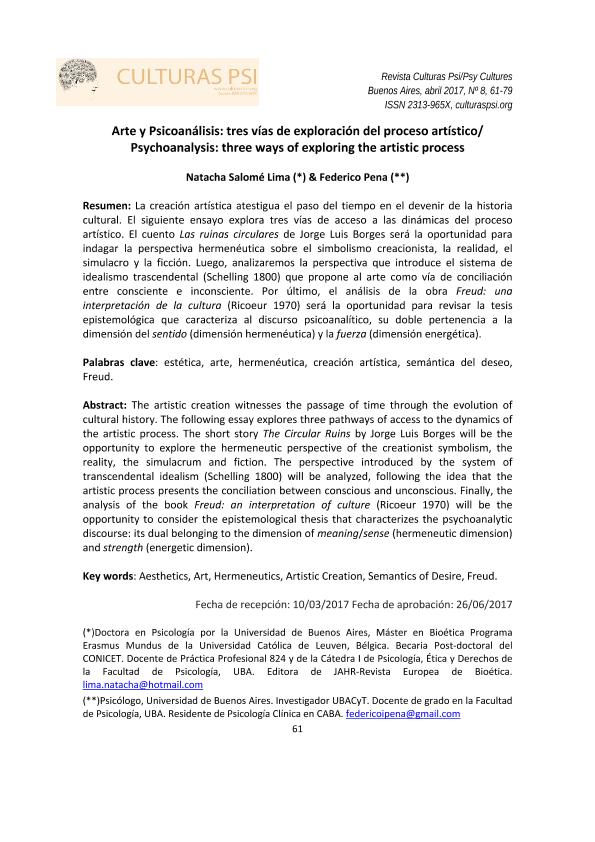Artículo
La creación artística atestigua el paso del tiempo en el devenir de la historia cultural. El siguiente ensayo explora tres vías de acceso a las dinámicas del proceso artístico. El cuento Las ruinas circulares de Jorge Luis Borges será la oportunidad para indagar la perspectiva hermenéutica sobre el simbolismo creacionista, la realidad, el simulacro y la ficción. Luego, analizaremos la perspectiva que introduce el sistema de idealismo trascendental (Schelling 1800) que propone al arte como vía de conciliación entre consciente e inconsciente. Por último, el análisis de la obra Freud: una interpretación de la cultura (Ricoeur 1970) será la oportunidad para revisar la tesis epistemológica que caracteriza al discurso psicoanalítico, su doble pertenencia a la dimensión del sentido (dimensión hermenéutica) y la fuerza (dimensión energética). The artistic creation witnesses the passage of time through the evolution of cultural history. The following essay explores three pathways of access to the dynamics of the artistic process. The short story The Circular Ruins by Jorge Luis Borges will be the opportunity to explore the hermeneutic perspective of the creationist symbolism, the reality, the simulacrum and fiction. The perspective introduced by the system of transcendental idealism (Schelling 1800) will be analyzed, following the idea that the artistic process presents the conciliation between conscious and unconscious. Finally, the analysis of the book Freud: an interpretation of culture (Ricoeur 1970) will be the opportunity to consider the epistemological thesis that characterizes the psychoanalytic discourse: its dual belonging to the dimension of meaning/sense (hermeneutic dimension) and strength (energetic dimension).
Arte y Psicoanálisis: tres vías de exploración del proceso artístico
Título:
Psychoanalysis: three ways of exploring the artistic process
Fecha de publicación:
06/2017
Editorial:
Instituto de Desarrollo Económico y Social
Revista:
Culturas psi
ISSN:
2313-965X
Idioma:
Español
Tipo de recurso:
Artículo publicado
Clasificación temática:
Resumen
Palabras clave:
Estética
,
Arte
,
Hermenéutica
,
Deseo
Archivos asociados
Licencia
Identificadores
Colecciones
Articulos(SEDE CENTRAL)
Articulos de SEDE CENTRAL
Articulos de SEDE CENTRAL
Citación
Lima, Natacha Salomé; Pena, Federico Ignacio; Arte y Psicoanálisis: tres vías de exploración del proceso artístico; Instituto de Desarrollo Económico y Social; Culturas psi; 8; 6-2017; 61-79
Compartir




